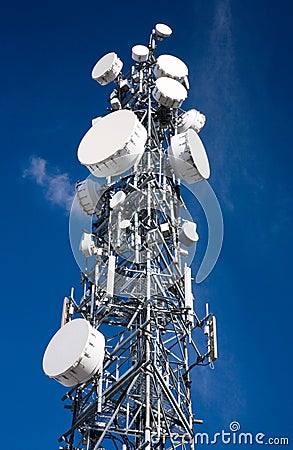That's still not enough information.
Does the beam spread or is it concentrated energy?
For example, a couple of minutes of exposure to near IR, UV and visible light from the sun will not cause any damage, even on clear day, at the top of a mountain, at midday on the equator, but concentrate the energy using a magnifying glass or parabolic mirror and it can cause severe burns.
If I have it right, the parameter you're homing in on here is W/m2 - and it is certainly key to answering the question quantitatively, but for the sake of argument, let's just pick an average microwave antenna that you might find in a place like this:

But before this continues into farce (and I'm sure some will say 'too late'), I would like to cut to the chase...
Even if all the parameters you wish to throw down as a challenge are defined - would you then attempt to answer the question?
I somewhat suspect the answer is 'not really'. If so, this highlights the point that I have been trying to show - that we can are fairly clear about very low levels being safe and very high levels being unsafe, but we don't have much confidence in defining the risks over the transition zone or even where the transition zone starts and ends.
Parabolic dish antennas are designed to convert diverging rays into parallel rays
( OK ,wavefronts are not really rays,but it is how such reflectors are explained,both in optics & antenna descriptions)
Imagine ,a Parabolic dish used as a receiving antenna:-Parallel rays from the remote station strike the dish,are reflected at an angle depending upon its curvature at that point,& all converge at the focal point of the Parabola,where the feed device,
(let us assume,a dipole) is situated.
The transmit case is the converse of the above.
The RF signal is radiated from the dipole into the dish,& is reflected as parallel rays which then proceed to the remote receive antenna.
There is only one “focal point” with such an antenna,& that is where the feed device is situated.
Even if it were possible to "focus RF signals to a point"somewhere in mid-air using such antennas,there is nowhere in Communications where such a thing would be useful.
Note on EIRP:-Say the dish has a specified gain of 28dB &,the dipole has a gain of around 2dB,both w.r.t Isoptropic,for a total gain of 30dB.
If the dipole is driven with 1 Watt of RF,
to the remote receiver the signal strength received is the same as that which would be supplied by an Isotropic antenna driven with 1kW.
Remember,however,the original 1W is all you have to work with,distributed across the whole area of the Dish.
If you suspend yourself 1m in front of the dish your body will only intercept some of that 1 Watt.
To the signal,you are two dimensional---parts of your surface area which don’t face the antenna don’t count.
I don't think your question is something that can be easily resolved.
The RF Exposure Rules are extremely conservative,for that very reason.
Frequency is important-----I have spent longer than 1 Hour within a few metres of the base of an MF Radiator fed with 60+kW.& longer than that on another occasion working in close proximity to a HF curtain Array fed with 50kW.
I have also spent the best part of an hour behind VHF antennas fed with 10kW (EIRP 100kW).
I would be very wary of Microwave signals at such levels.
Quite apart from the fact that high gain antennas usually make it unnecessary to produce extreme levels of
real power at Microwave frequencies,most people do not spend a lot of time in front of such antennas because by their very nature they are "up in the air".
Maritime & Military people are more likely to be exposed to high levels of Microwave RF power,due to the fact that RADAR does produce
real power levels in the kW region,as witness folks getting eye damage by looking down waveguides.